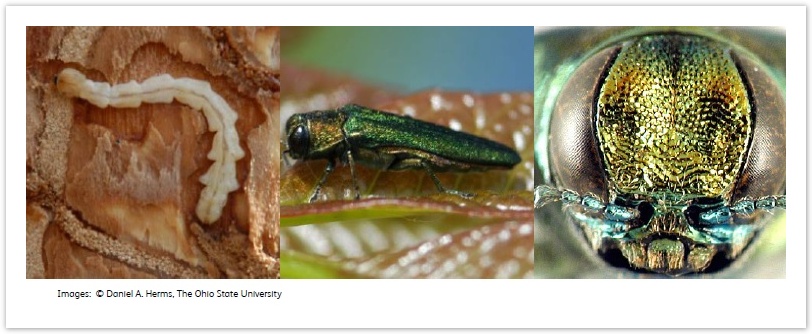

British ash trees are not only threatened by ash dieback (ADB), but also by the emerald ash borer (EAB) beetle which has killed tens of millions of trees in North America. In the long term, Britain needs ash trees that are resistant to both ash dieback and EAB. To achieve this, we need to study genes in the whole ash genus, which consists of about 50 species worldwide. Initial studies suggest that some of these species are resistant to either or both ADB and EAB due to co-evolution. This project will pioneer the application of a new method for finding the genes responsible for these traits. This works by building evolutionary trees for thousands of genes within the ash genus and examining how patterns of gene evolution fit with patterns of resistance to ADB and EAB. This evolutionary approach may allow us to identify the genes that may be involved in resistance.
For this method to work, accurate information is needed about the vulnerability of different ash species to ADB and EAB. To achieve this, the researchers will conduct an experiment in the USA looking at the susceptibility of ash species to EAB. A similar experiment will be carried out in the UK on clones of all the ash species available in British and Irish living collections. A social science study will complement the experimental work, discussing ways to enhance tree health in a manner that is socially and politically acceptable. If successful, these approaches can be used to tackle tree health issues in other tree species.
Project website http://www.ashgenome.org/
This project is in partnership with Forest Research and University of Oxford (project participants).
Specific objectives (edited for this web site):
1. To develop a new approach for identifying genes and alleles conferring reduced susceptibility to tree pests and pathogens, using phylogenomic information derived from the whole genus of Fraxinus (ash) a tree species that is at threat. This approach will exploit new DNA sequencing technologies and apply the latest methods in phylogenomics, pioneered by co-PI Rossiter. Fraxinus (ash) faces two major threats, and preliminary evidence shows resistance to both threats to have evolved in parallel more than once in the genus. We will sequence and assemble the genome of every species in the genus Fraxinus for which we can obtain living material (35 species), except F. excelsior (already being sequenced). The genome assemblies will be places in a multigenome alignment representing the pan-genome of the genus Fraxinus. A set of candidate genes and alleles for reduced susceptibility to Emerald Ash Borer and ash dieback will be identified in relation to species susceptibilities. A set of recommendations about how genes and alleles for low resistance to ash dieback and EAB can be implemented in UK contexts.
2. Quantify the susceptibility of all available species in Fraxinus to ash dieback. We will propagate as many living species of Fraxinus as are available in UK living collections, and plant them in UK sites where they will be exposed to high inoculum levels of ash dieback, and measure extent of ash dieback infections within and among individuals.
3. Quantify the susceptibility of all available species of Fraxinus to Emerald Ash Borer, including European species that have not yet been exposed in the wild. We will also propagate as many living species of Fraxinus as are available in USA living collections, and inoculate them with Emerald Ash Borer(EAB) larvae in Ohio, USA to quantify susceptibility/resistance to EAB within and among individuals. Inform UK policy makers about the risks of EAB to the UK.
4.To understand the attitude of the UK public to the potential use of genus-wide genome diversity in trees to combat tree health threats, and assess the political acceptability of using different approaches to reduce the threats, such as: a) planting resistant species in the UK, b) breeding programmes involving hybridisation with resistant species, or c) transfer of genes from resistant species into UK species by genetic modification.
5. To communicate results to scientists, foresters, policy makers and the public.
6. To strengthen the UK skills base in tree health.
|